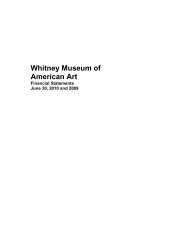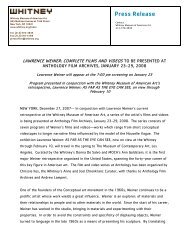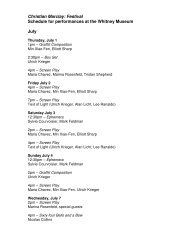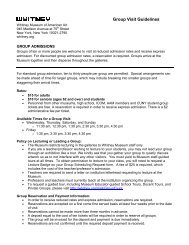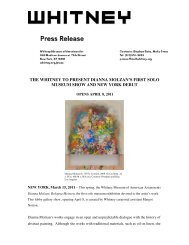Post-visit Materials for Teachers - Whitney Museum of American Art
Post-visit Materials for Teachers - Whitney Museum of American Art
Post-visit Materials for Teachers - Whitney Museum of American Art
Create successful ePaper yourself
Turn your PDF publications into a flip-book with our unique Google optimized e-Paper software.
<strong>of</strong> otherwise documentary images and a sense <strong>of</strong> alienation and disorientation. The mall becomes<br />
a hostile, dangerous place.<br />
Rashaad Newsome has created a video <strong>of</strong> a man dancing by himself in a white room. He asks<br />
dancers to per<strong>for</strong>m “vogue” dance moves. Vogue is a <strong>for</strong>m <strong>of</strong> modern dance that is inspired by<br />
poses in fashion magazines. The artist says, “I view these videos as drawings with the dancers<br />
acting as my pens creating lines, shapes, landscapes, and …narratives.”<br />
Charles Ray’s drawings <strong>of</strong> flowers are at once cheerfully lifelike and eerily abstract. Rendered in<br />
bright hues or deep blacks, the flowers occupy the page in fluid arrangements. Yet the individual<br />
petals are also composed <strong>of</strong> discrete plumes <strong>of</strong> color, as though Ray conceived <strong>of</strong> each as a<br />
separate <strong>for</strong>mal element be<strong>for</strong>e joining several in a tenuous whole. Ray is best known <strong>for</strong><br />
sculptural works that painstakingly replicate everyday objects, but with subtle, psychologically<br />
charged alterations that confound the distinction between real and unreal. His depictions <strong>of</strong><br />
flowers extend a longstanding interest in the beauty <strong>of</strong> natural <strong>for</strong>ms that characterize his threedimensional<br />
work.<br />
Aki Sasamoto’s installations and per<strong>for</strong>mances explore the nuances and peculiarities <strong>of</strong><br />
everyday life. She uses sculpture, movement, video, and sound to trans<strong>for</strong>m mundane actions<br />
into theatrical events. Strange Attractors consists <strong>of</strong> a careful arrangement <strong>of</strong> sculpturally altered,<br />
found objects that take on new roles and provide guidance <strong>for</strong> Sasamoto’s improvisational<br />
per<strong>for</strong>mances that take place within the installation.<br />
Ania Soliman’s work, NATURAL OBJECT RANT: The Pineapple comprises twenty-six<br />
montages, each corresponding to a letter <strong>of</strong> the alphabet, and twenty-six text panels that explore<br />
the pineapple's history as an exotic commodity tied up with the politics <strong>of</strong> colonialism.<br />
Reminiscent <strong>of</strong> Dadaist photomontages from the 1930s such as those by German artist Hannah<br />
Höch, each montage is a hybrid <strong>of</strong> two digital images, sourced from the internet. The<br />
accompanying panels <strong>of</strong> text are written by the artist and in<strong>for</strong>med by her research and<br />
impressions on the subject <strong>of</strong> the pineapple and its historical significance.<br />
Storm Tharp builds his strange and beautiful characters from a series <strong>of</strong> ink drops in water,<br />
improvising and developing the image from feathered lines and washes <strong>of</strong> ink as he works. Tharp<br />
takes his inspiration from a wide-ranging set <strong>of</strong> influences including 1970s <strong>American</strong> cinema and<br />
Japanese portrait prints. His characters have names, histories, and narratives, but suggest<br />
multiple interpretations.<br />
According to Tam Tran, she trains her camera on “everything and anything my eyes see and<br />
love.” Tran’s series <strong>of</strong> photographs presents her subjects as multi-faceted characters, who<br />
explore and experiment with their respective identities by taking on a multitude <strong>of</strong> personas. In the<br />
series Raising Hell (2008), the artist’s nephew enacts a typical childhood fantasy <strong>of</strong> being a<br />
superhero. He is featured wearing a costume <strong>of</strong> pajamas and a cape and uses a broomstick as a<br />
weapon. Each <strong>of</strong> the five photographs captures a different moment in the battle between the boy<br />
and his imagined backyard adversary.<br />
Pae White's work encourages viewers to take a deeper look at familiar encounters and ordinary<br />
objects to the end <strong>of</strong> enriching everyday experience. Ignoring traditional boundaries between the<br />
applied and fine arts, White draws attention to what she calls "the spaces between things" in<br />
transient sculptural installations and graphic design projects that are temporary by nature. In 2006<br />
White began creating tapestries with photographic images <strong>of</strong> crumpled aluminum foil and, later,<br />
plumes <strong>of</strong> smoke. Still, Untitled (2010) is the latest <strong>of</strong> the smoke tapestries, which stage what<br />
White describes as the cotton’s “dream <strong>of</strong> becoming something other than itself” by contrasting an<br />
image <strong>of</strong> something immaterial with the physicality <strong>of</strong> fabric.<br />
© 2010 WHITNEY MUSEUM OF AMERICAN ART<br />
10




